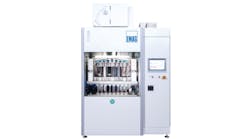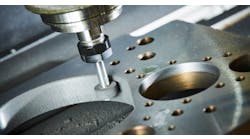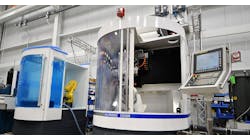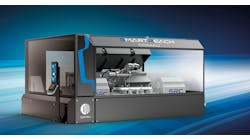Preloaded Systems for Precise Positioning
2025 Outlook for Manufacturing Technology
More Improvement in US Machine Tool Orders
5-Axis Machining for Large Parts
Ivan Cuscov started working as a mechanical engineer at Cerin SpA ten years ago, and today he is manager of the toolmaking plant in Verona, Italy, responsible for overseeing manufacturing of the rotary burrs, end mills, core drills, reamers, and countersinks produced there.
“Cerin was founded in 1971 by Mr. Cerin and my father joined the company a few years later,” Cuscov explained. “We were one of the first Italian companies to work with solid carbide and today serve many industries, from aerospace to construction, shipbuilding, energy and automotive.
“Half our sales are in Italy and the other half abroad,” he continued, “mainly exporting to Germany but also Russia and Japan, China and England. Our customers choose to work with us because we manufacture a good product. If you ask our customers to say something about Cerin, they will only say, ‘A Cerin tool is a good tool.’ And that's what I think is what makes us successful.”
The plant manager recalled that during its 50-year history Cerin never manufactured high-speed steel tools because of an instinct that “solid carbide was the technology of the future.”
And producing solid-carbide tools was no easy step. “It was very challenging at the time, as there was limited knowledge on how to use solid carbide. Many people in the industry didn’t know of diamond wheels and thought of diamond as a jewel and not a grinding material,” Cuscov recalled.
Despite the difficulty, taking up the solid-carbide challenge has been critical to the firm’s success.
Investing to stay ahead of technology change – Working to understand customers’ production requirements, evaluating the machining processes and shop practices, is one part of the Cerin’s technique. The firm also installed a development center to test new materials and new machining technology.
“Currently, we are looking into the exotic nickel alloys, otherwise called high temperature alloys - which are still niche materials,” he said, “but we think it's important to understand, given the increasing requirement for energy-efficient engine performance. For these applications, high performance requires higher thermal mechanical properties, and that is driving tool technology.”
The development lifecycle – Cuscov describes a good tool as a combination of proper geometry, carbide material, and coating. Developing a new tool may require a few weeks, or many months, starting with a design, followed by testing a basic design of a specified length and diameter, fulfilling the initial targets.
“After that you need to organize the whole commercial offer,” he said, “extend the tests to the rest of the product family, and of course create the stock availability.”
Cerin produces standard tools during weekend hours, at times with unmanned shifts, which helps to contain production costs, increasing our capacity. Operators create optimal production conditions, looking at correct machine and grinding wheel set-ups. Our attention to detail when setting up processes means we can guarantee quality.”
During and after production, the tools are frequently checked for product quality, during and after production, and the shop maintains complete traceability of all materials and finished products.
Cerin’s production standard and cylindrical endmills and drills is done on a selection of ANCA CNC machines – MX7, MX7 Linear, FX7 Linear, GX7, TX7, and a TG7.
“Precision, repeatability, and stability are three advantages of using ANCA machines and over the years we have found ANCA machines to be thermally stable with a wide range of technology offered,” Cuscov said. “A stable grinding machine is very important for unmanned shifts to keep tolerances and tool dimensions under control. In fact, repeatability means that we have the grinding process under control and can be confident with the quality of the end product we deliver to our customers.”
The shop also uses ANCA’s iGrind software program, which the manager salutes for its simplicity and flexibility, and ANCA’s ToolDraft in combination with AutoCAD.
“We have been recently using iView with a camera for profile tools and it looks promising because it is a good way to control the tolerance of a complex tool all along the profile,” Cuscov explained. “If a profile is being controlled at a single point it is too difficult if you are trying to keep a whole profile within a certain tolerance to a few microns. For that you need a specific device and iView is very interesting.”
The shop also has adopted ANCA’s Wheel Probe process-control technology, which references the grinding wheel directly on the machine, saving set-up times and allowing the operators to take measurements directly on the machine.








